Taxis by country
This article has multiple issues. Please help improve it or discuss these issues on the talk page. (Learn how and when to remove these template messages)
|
Africa
Egypt


Taxicabs are common in
Meters are technically required by Egyptian law, but they generally go unused and in many cases do not even work. The prime exception is in Cairo, where a new class of taxis with a different livery (white with a black checkered band around the middle) have electronic meters installed and used. In most other cases, the price of a journey is generally determined through negotiation or bargaining between the passenger and driver, either just after the cab is hailed or just after the destination is reached.
Many if not most Egyptian taxi drivers have some education and frequently work in
Eritrea
In Eritrea all taxis are yellow. In the capital, Asmara, they are all new yellow Kia, Toyota, and Mercedes Benz. There are often five passenger seats. The taxis are owned by the same company all over Asmara. The taxi traffic starts slowing down after 9 pm in the northernmost part of the city's suburbs, but the inner city and southern side of the town have a lot of taxis. The taxis in Massawa are often large like minibusses, but are still taxis. They are also yellow.
Ghana

Most taxis in Ghana have orange coloured wing panels. According to some observers, the vast majority of vehicles on the roads are taxis. Taxis either take a customer anywhere on a pre-negotiated fare, or pick up passengers for a fixed fare on a specific route.[1]
Morocco

Since 2014 the Moroccan taxi industry is living major changes. Historically the taxicabs were Mercedes. Since 2005 with the new touristic transport companies, taxis now can use other types of vehicles.[citation needed]
Republic of the Congo (Congo-Brazzaville)
Taxicabs in the Republic of the Congo are almost exclusively Toyota, often old cars imported from Asia or Europe. In Brazzaville, taxis are green and white. In the second largest city in the country, Pointe-Noire, taxis are blue and white.
South Africa

South Africa has two kinds of taxis, minibus taxis which are vehicles that seat fifteen, and meter cabs that seat between four and seven passengers. Minibus taxis and meter taxis are mostly Toyota-manufactured. Minibus taxis use the Toyota Ses'fikile (a modified Quantum/HiAce produced specifically to meet the regulatory requirements of the South African taxi market)[2] and meter taxis Toyota Avanza. Minibus operate on specific routes like buses. Meter taxis cabs operate from point to point.
Asia
Israel


There are two taxi systems in Israel, with one operating as a standard taxi service and the other (taxi - sherut) as a cross between a taxi and a private bus system. The latter tends to run longer journeys or particular routes and is effectively a shared taxi – hence set pick-up and set-down locations, but also potentially picking up or dropping off anywhere en route. Although fares are officially meter-based, it is quite common to agree on the fare in advance with the driver. They have a directory guide for prices and will show the estimated alternative to the meter price, either to be accepted, negotiated or rejected by the traveler if the meter is preferred. The wisdom of the choice may be based on time of day and traffic and whether the passenger has bags, etc. which could cost more on the meter as each piece adds a set amount. Either way, the eventual fare is not usually significantly different so many Israelis choose the meter without a thought. Tipping is not required but rounding up is common.
Standard taxis are always painted white with decals on the sides that say "Taxi" in
Palestine (Gaza Strip and the West Bank)
Taxis in Palestine have either black and white stripes or are yellow colored depending on the location.
Private taxi companies in the Gaza strip often use Škoda Octavia wagons as their main vehicles while individals in south of Gaza use 80s 6 door Mercedes limosines as taxis, the Hyundai Verna is also used as taxis.
Oman

Taxicabs in Oman are usually with orange panels and mostly Toyota or Nissan models. The number plate is red and starts with K, KA, KB (for saloons) and KK (for vans). They do not have any meters installed. The fare is generally decided by bargaining with the driver, though most commuters have a good idea of what can be considered a reasonable price. The rider may choose to have the taxi "shared", or "engaged." In an engaged taxi, the driver will not take any more passengers (as opposed to a shared taxi). Usually, drivers charge much more to have the taxi engaged, sometimes as much as eight to ten times the price of a shared taxi. In a shared taxi, the driver will usually get more people who need to go along the same way. Due to low costs of fuel and fairly high purchasing power parity in Oman, taxicabs are extremely cheap when compared to other parts of the world, even in the engaged mode.
A variation of the shared taxi also exists. These are usually 12-seater Toyota vans. These taxis follow a fixed route, stopping mostly at bus stops to pick up and drop off passengers. Passengers usually get into the taxi that is headed towards their destination. To attract more passengers, taxis stick to highways and main roads. If one wishes to go towards a place, not along the main road, it is generally more economical to use a shared van to commute between two bus stops and then switch over to another taxi headed for the destination, as opposed to taking the regular taxi to commute between the two places.
Afghanistan
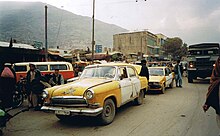
Old-style Toyota Corolla, Toyota Corona, GAZ-21"Volga", VAZ-2101 "Zhiguli", and Lada taxicabs in Afghanistan are still used as regular taxis.[citation needed]
Bangladesh
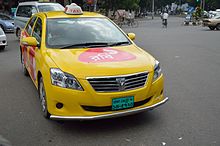
Taxis in
China

Taxicabs are very common throughout China. Different vehicles are used throughout China due to various provinces and cities' taxi company choices. Formerly, commonly used taxi cars were the Volkswagen Santana, Citroën Fukang and Citroën Elysée.[3][unreliable source?] Following Shenzhen, many cities in China started using fleets of EV taxis,[4][5] using vehicles such as the BYD e6.[6]
Regulation require taxicab drivers working for ride hailing apps to have three years of experience, have a licence from a local taxi regulator and have no criminal record. Their vehicles cannot have over 600,000 kilometers on the odometer and are required to have GPS tracking.[7]
Macau
Hong Kong


During the early
The pulled rickshaw, first imported from Japan in 1870, was a popular form of transport for many years, peaking at more than 7,000 in the early part of the 20th century.[11] The rickshaw and sedan chair vied for customers depending on their budget, haste, or terrain to be negotiated. The rickshaw was more rapid, but was not suited to climbing the steep terrain of Hong Kong Island.[11]
Rickshaws' popularity waned after World War II. There were about eight in 1998,[11] and only four left in 2002. The last sedan chair was reportedly abandoned in 1965;[11] and the rickshaws have disappeared since the ferry's closure at the end of 2006.
The earliest modern taxi service was first officially recorded by the
In Hong Kong today, there are three types of taxis, painted in different colors, serving different parts of the territory. The most common one, which is painted in red. The red taxi serves throughout Hong Kong Island and Kowloon. Green taxis serve the New Territories and light blue taxis serve Lantau Island. Taxis pick up passengers from streets, or by radio-dispatch by phone. Fares are charged according to the distance measured by meters. Surcharges include tolls, luggage, and pets.
India
In India, taxicabs have a yellow-black livery. The newer taxis are white. Taxis and all other commercial vehicles have a yellow number plate so charging taxes and toll on highways are easier for the officials.

Depending on the city/state, taxis can either be hailed, booked through applications, or can be hired from taxi-stands. In cities such as Bangalore, taxis need to be hired from taxi stands or online, whereas in cities like Kolkata and Mumbai, taxis can be hailed on the street. There are additional surcharges for luggage, late-night rides, and toll taxes are to be paid by the passenger. Thanks to the booming economy but due to disparities in income, many types of taxis have come up. For example, in Delhi there are five types of taxis. Auto rickshaws (most affordable), normal taxis, radio cabs, white taxis, and tourist taxis. In areas like Noida and Gurgaon, auto rickshaws are banned, thus giving the taxis a monopoly. Chandigarh also has a well-established system of modern radio cabs.
By government regulation, all taxis are required to have a fare meter installed. Taxis face stiff competition from auto rickshaws but in some cities, for example, Mumbai, auto rickshaws are banned in the main city district, thus giving taxis a monopoly. This monopoly directly affects the kind of cars used in India as cabs as well as the kind of economical and transport conditions.[citation needed]
Indonesia
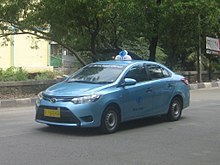

Taxicabs began to be popular in Jakarta from the early 1970s with cars such as the
In the 1970s, taxicabs were in various colors, although at that time mostly yellow, and a major operator ran light blue taxicabs. The main vehicle replacement for most taxicab operators was in the mid-1980s when they replaced their old fleets with
Due to poor sales in the private car market, but good fuel economy and reliability, Holden Gemini diesel cars were used as taxicabs during the 1980s. The same happened to Nissan Sunnys and Ford Lasers from the late 1980s to the late 1990s.
Since the color of the most reliable taxicab company in Jakarta is medium blue metallic (previously light blue), few other operators copied their color and even the shape of the roof sign. This could be misleading to people hailing the taxicab on the street. Although most taxicabs are blue, they are also painted in other colors, dependent on the operator.
The new taxicabs in Jakarta are mostly Toyota Limo, which is a lower spec of Toyota Vios. Before the introduction of Limo in 2004, the most popular taxi was Toyota Soluna, which based on the 1995 Toyota Tercel. The Solunas and the older variants of Limo are now used by cheaper taxicabs. Other cars also used as taxicabs are Hyundai Excel, Ford Laser, and Kia Rio. Only one operator ran the Nissan Sunny 1.6 Neo (N16) and later replaced by the newer Nissan cars; the Tiida Latio and the Almera. By 2014, the Nissan Almera (N17) is also commonly used for taxicabs ran by several operators. Honda Mobilio 7-seater is also used since 2015.
There are also executive taxicabs; these are black Nissan Cedric Y31 and Toyota Crown Comfort, and recently a W203 Mercedes-Benz C-Class, a W211 Mercedes-Benz E-Class, a Toyota Alphard, a Hyundai Sonata, and a Nissan Elgrand.
Since the Soluna and followed by the Vios-based Limo, Toyota's small sedans are used for regular taxicab services in Indonesia. However, in the executive taxicab segment, only a few Toyota Crown Comfort. In 2007, the executive fleet saw the arrival of the Mercedes-Benz C-Class, followed by the Mercedes-Benz E-Class and the Toyota Alphard in 2009. An executive taxicab operator has added the Volkswagen Caravelle to its fleet, and soon the Hyundai Starex.
As of early 2016, various taxi firms also began to use the Toyota Avanza mini MPV as an alternative fleet, particularly in Sumatra, Borneo, Central Java, and East Java regions.
Japan


In most parts of Japan, there are many taxicabs of various colors and styles. Japan has no limitation on taxicab design, so each taxicab company adopts its own design, although owner-driver taxicabs use a prescribed design. In Osaka, most taxicabs are black because they are also used as limousine taxis.
In the run up to the
Malaysia

In Malaysia, taxicabs are also referred to as teksi. There are several taxi operators running within Malaysia. Most taxicabs use their preferred car of choice, the
Philippines

Taxicabs in the Philippines are usually white with yellow commonly used as airport taxis.[14] In metropolitan Manila, some cab companies use bicolour configurations to help distinguish their cars from other companies.
Singapore



Total fleet: 82,130[15] (As of July 2019[update])
Every taxicab in Singapore is fitted with meters. ComfortDelGro is the only company that has flat fare booking on the app itself, with a system limitation of one destination. Dynamic pricing was introduced in May 2019 through "ComfortRIDE". ComfortDelGro was the only one to use Uber until Uber's operations in Southeast Asia merged into
In the mid-1960s, the first taxicab company had their vehicles painted black with a yellow rooftop. The model was a
Early examples used the
Currently, the
Various models were used, such as
Sri Lanka
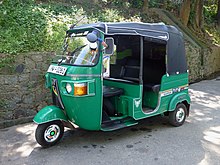
Most of the cabs are run by locals in their auto rickshaws.
South Korea


There is an extensive taxicab system, with about 70,000 taxis in Seoul alone.[17] Altogether there are about 250,000 taxis in the whole of the country.[18]
In cities such as Seoul and Busan, taxicabs are very common. There are three types: an "ordinary" (ilban; 일반) taxi; a "deluxe" (mobum; 모범) taxicab, which is painted black and is bigger and much more expensive; and a 'taxicab for the handicapped' (jang-e-in call taxi; 장애인콜택시), yellow vans with accessiblity enhancements. There are also two types of taxicab drivers' licenses: all taxicab drivers start driving their taxicab as employees in the taxicab companies, and these taxicabs that belong to a company are called 'corporate' (bubin; 법인) taxicabs. After years of service in the taxicab company, drivers get a license which allows them to purchase their own vehicle and drive it as a self-employed driver, and the taxicabs they then drive are called 'individual' (gaein; 개인) taxicabs.
For 'ordinary' taxicabs, there is an extra 20% increase in fare after midnight, but this does not apply to the 'deluxe' taxis. Most 'ordinary' taxis are silver or white in color. Virtually all South Korean taxicabs are South Korean car models, and meter fares start at 3,800 South Korean won. The fares are much cheaper than in major cities in Europe and North America, and no extra fares are charged for luggage. All taxicabs are labeled in Korean with a sign 'individual' (개인), 'deluxe' (모범), or the name of the company if the taxicab belongs to a taxicab company, and have a half-sphere on top of a half-pyramid, or to a lesser degree a silhouette of a traditional Korean gate attached on the roof and labeled "TAXI".
Taiwan
The
Historically whenever major crimes have occurred, many people, especially women, have felt less confident riding taxis due to safety and security concerns, causing taxi drivers to carry even fewer passengers.[citation needed] Throughout the 1990s in Taipei, violent clashes resulting from traffic disputes broke out between rival taxi companies.[20] After two major murders in late 1996, Yao Kao-chiao, the director-general of the National Police Agency, said that his daughter would not dare to ride in taxis.[21] Many taxi drivers considered his speech impacting and discriminating against them.[22]
For some time, taxis in Taiwan were required to be yellow.[23] The common color scheme led to taxis being known by the colloquialism "little yellow".[24][25] This stipulation was relaxed in 2016, as regulations applying to taxis and ridesharing companies were amended.[26][27][28] Uber entered the Taiwan market as an information service provider in 2013, and began operating what the Ministry of Economic Affairs Investment Commission determined was a passenger car service instead.[29][30] After this finding, an amendment to the Highway Act was passed in December 2016, increasing the fines levied on illegal taxi service operators.[31][32] As a result, many ridesharing companies withdrew from Taiwan.[33] In 2017, new regulations came into force, permitting rideshare companies to partner with vehicle rental companies,[34] and stating that rideshare drivers must be licensed commercial drivers.[35] A 2019 amendment to Article 103-1 of the Transportation Management Regulations, dubbed the "Uber clause," barred rideshare companies from forming partnerships with vehicle rental agencies.[36][37] That same year, Taiwan began to offer multipurpose taxi service driver exams. Drivers for such services do not have to use yellow vehicles, and are paid a metered fare, but passengers must use an app to make initial contact.[38][39]
Thailand

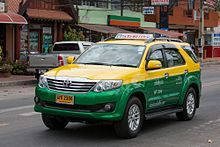
Taxis are widely available in Bangkok and come in many different colours (because of different groups or companies). Most are metered.
Bangkok taxis come in various colours, including single-colour, bi-colour and single-colour with strip. The single-colour taxis are a company taxi, personal taxi in cooperation or alliance, and rental company taxi. The colours include bright green, bright sky blue, red, orange, yellow, blue, pink, purple, violet and tan. There are three kinds of bi-colour taxis, including yellow and green, red and blue and yellow and orange. The yellow and green taxis are personal private taxis. The red and blue taxis are rental taxis. Yellow and orange are company taxis.
In Bangkok, there are also airport taxis known as AOT Limousine. These cars are in silver.
There are also taxis in
Vietnam

The regular Vietnamese taxi market is dominated by two firms, Mai Linh Group and Vinasun.[40] Motorbike taxis, known as xe ôm, are also common.[41] The main ride-hailing app operators are Grab and Go Viet, a subsidiary of Gojek.[42] Unlicensed taxi drivers and transport services are known for soliciting customers rudely.[43][44]
Europe
Albania

In Tirana, the capital city, taxis are all painted in yellow, with various signs on the roof. Official taxis have yellow plates with red text. The Albanian word is taksi, but most of the signs are in English. Lately,[when?] the law has required taxi drivers to buy cars that are less than 10 years old. 90% of taxicabs are private: there are only two companies operating and they only operate in Tirana. Apart from these two companies, very few drivers use taximeters.[citation needed]
Bulgaria

Until the fall of socialism in Bulgaria, all taxis were
Finland

After World War II, Russian cars, especially Pobeda and Volga, dominated the taxi market in Finland for several years. In the late 1950s, the import restriction on cars was lifted for taxi operators, which made it feasible to import western cars in larger numbers. By the end of the 1960s, Mercedes-Benz in particular had gained a dominant position, accounting for up to half the taxi stock, and the Finnish distributor of Mercedes, VEHO, even has a separate taxi sales department. Mercedes has remained the archetypal taxi ever since, although other makes such as Volvo (especially estate models) and Volkswagen Audi Group (VAG) brands are also common.
Taxis in Finland do not have to be liveried in any particular colour or pattern. They are recognisable from the yellow TAKSI sign on the roof, which is illuminated when the taxi is available for hire. Taxis mainly gather at special taxi ranks, instead of being hailed. Customers either walk to the taxi rank and take the first available taxi from the front of the queue, or wait at the rank for a taxi to appear. One can also order a taxi by telephone or app to a specific address.
France

The first horse-drawn forerunners of taxis appeared on Parisian streets in 1637. France was one of the first countries to use modern taxis—that is, gasoline-powered vehicles with fare meters in 1899. New York's first taxis were imported from France in 1907, and taxis were famously used for troop transportation during the First Battle of the Marne. Within the last two decades[when?] a large number of taxis in France were Peugeot cars, among them the mythic Peugeot 406 used in Taxi, the French action-comedy film.[citation needed]
Germany

An important event in the history of the taxi was the invention of the
In Germany, taxis were required by law until November 2005 to be light ivory (
Hungary

In Budapest, the capital of Hungary, all taxis must be painted yellow since 2013 and vechicles must be younger than 10 years old.
Ireland

In the
The term
Both taxis and hackneys are licensed by the National Transport Authority.[47]
Italy

In Italy, taxicabs are white (previously they were yellow, in the 1950s and 1960s they were green-black or red), with a small illuminated TAXI white (previously red) sign on a black background on the roof of the car. There are 25,186 taxis in the country (1 for every 2,412 people).
Lithuania
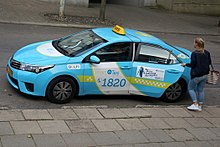
In
Netherlands

In the Netherlands, electric Tesla cars are slowly replacing diesel and petrol cabs.[53] All taxis have light blue license plates with black characters.
Norway
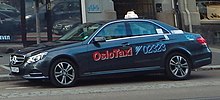
In Norway, the end of 2009 roster showed that 41.9% of the 8961 taxicabs were from Mercedes-Benz, and several manufacturers that can offer a diesel-engined executive car are represented. 91.6% of Norwegian taxis are equipped with diesel engines.[needs update] Among maxitaxis (minibuses operating as taxis), Mercedes-Benz vehicles such as the Mercedes-Benz Sprinter constitute 70% of the fleet.[54]
Taxicabs are usually distinguished by small company decals on the
In 2011, the most popular models of vehicles used as taxis were the
Romania

Taxicabs in Romania are usually yellow, like in New York City, but this is not a universal rule. For instance, in Braşov County, some cabs are white; in Arad County, most are white. The company name, taxi fare, and license number are written on the car doors. Taxis do not include the ride from the waiting station to the pickup point in the fare.[citation needed]
Russia
Regulated official taxicabs, identifiable by their yellow livery (from the 1st of July[
Gypsy-cabs can be hailed quickly in central Moscow by stepping up to the curb and raising a hand.[59] Driver and passenger will negotiate a price through the front window;[57] though occasionally the driver does not wish to go to the requested destination or the passenger and driver cannot agree on a mutually acceptable price, in which case the car may leave and the passenger is able to try their luck with another one.
While there is obviously a risk of crime in getting into a stranger's car in any city, using gypsy-cabs in Moscow is seen as relatively safe, though the British Embassy in the city officially discourages the practice.[60]
In contrast to taxicabs, pre-booked private-hire vehicles are readily available in Moscow on a conventional commercial basis.
Traditional cabs in the Western sense are becoming more and more common, but remain very expensive in comparison to the gypsy cabs.
In Russia there also exists a luxury taxi service where taxis are
Slovenia
In Slovenia taxicabs are called TAKSI and there's an inscription on the roof and on the doors. There's no rule for the taxi colour (except in Koper and Sežana where the taxis are white).
Soviet Union

In the latter years of the Soviet regime, the most common cars used as taxis were the GAZ series vehicles. There are two modifications: the GAZ-24 "taxi" and old series GAZ-21 "taxi".
Spain

In Spanish cities, as well as in small and large towns, taxicabs always have a meter. The models that can be used must be previously officially approved for this function by the local authorities, and they are always four-door sedans or minivans.
Regarding the livery, each town and city designates the colour of their taxis, but the overwhelming majority are white, usually with some kind of colour detail and/or local symbol on the doors. For example, in Madrid and Almería, taxicabs are white with a red diagonal stripe going through the front doors; in Seville, they are white with a diagonal yellow stripe down the rear doors; in Bilbao, they are white with a horizontal red stripe on the front doors. A notable exception is Barcelona, where taxicabs are fully black, except the doors and the boot lid, which are painted yellow.
Sweden
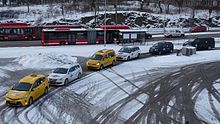
In Sweden, most taxis are painted black, yellow or dark blue, to some extent depending on the company's guidelines. There are many taxi companies, from big networks to single-car companies. License plates on Swedish registered taxis are yellow and all end with a "T" in a slightly smaller size than the other characters on the license plate. The tariff varies, but all taxis must have a taximeter and a price comparison chart visible in the car.
United Kingdom

There is a mature system of taxicabs throughout the United Kingdom. In 2015, there were around 298,000 licensed drivers in England, of which 164,000 were private hire licenses, 62,000 were taxi licenses and 72,000 were dual licenses.
"Hackney carriages" ("black cabs"; but they may be any colour) can be hailed in the street or hired from a taxicab rank. The term "Hackney carriage" can also be applied to standard passenger vehicles authorised by other
Taxicab service in London is regulated by
There are two other types of hire vehicles that act as taxis; they are known as private hire vehicles:
- A "private hire" taxi must be pre-booked, usually by telephone but also in some cases by e-mail or via in-car radio.[citation needed] Although not available to be hailed in the street, licensed private hire vehicles can offer a safe alternative to a "Hackney Carriage". The advantage of a private hire booking is that the journey is offered at a fixed price based only on mileage and not the variable time element of a taximeter found in a "Hackney Carriage"; unless the private hire vehicle is fitted with a taximeter in which case this meter must be used to calculate the fare. In many areas private hire and hackney vehicles have different coloured taxi licence plates; and also it is common that hackney carriages must be a certain colour (usually black, hence the term "black cab"), while private hire taxis may be any colour but that prescribed for hackneys.
- Chauffeur cars are a sub-set of private hire and historically have been mostly unlicensed. However, regulations now require them to be licensed. In limousinesare not still not licensed, and neither are their drivers. Generally, a prestige type of car such as a Mercedes or BMW is operated where the passenger pays a premium but in return receives a higher level of comfort and courtesy from the driver who may at times wear a uniform.
In Great Britain
Luton is reported to have the highest number of taxicabs per head of population in the United Kingdom.[64]
North America
Mexico

In Mexico City, according to Mexican legislation introduced in 2001, public taxicabs (in contrast with private taxicabs, or taxis de sitio) must be four-door, painted in red with a white roof, and almost all new taxis are Nissan Tsurus. Before 2001 most taxicabs were green Volkswagen Beetles with a white roof. They had the front passenger seat[clarification needed] removed in order to ease entry for passengers. At the moment,[when?] the taxi population is in a transition period, with both types in use.[66]
Originally taxis were yellow with a white roof, until they were changed in the mid-1990s (allegedly because yellow was the official colour of the
Trinidad and Tobago
In
United States and Canada


Throughout the United States (and Canada) there is a mature system of taxicabs. Most U.S. and Canadian cities have a licensing scheme that restricts the number of taxicabs allowed. These are sometimes called
Often taxi businesses own their own cars, and the drivers are hired by the company as independent contractors. However, cabs can also be owned by separately-incorporated small businesses that subscribe to a dispatch service, in which case the company logo on the door is that of the dispatch association.
A suburban taxi company may operate under several different names serving several adjacent towns. They often provide different phone numbers for each fleet, but they usually all ring into a central dispatch office. They may have subsidiary taxi businesses holding medallions in each town. Taxi companies also may run multiple businesses, such as non-medallion car services, delivery services, and school buses, for additional revenue, as the infrastructure required for maintaining, operating, and dispatching the fleet can be shared. Sometimes theme or entertainment-based taxis, like Funkmaster V's Uptown Cabs of Renown or Karaoke Kab, are popular taxi services in the United States.
Oceania
Australia

Australia used horse-drawn taxis once cities were established (as had been used in Europe in the early 19th century). Motor vehicle taxis were introduced into Australia not long after they were put into service in the United Kingdom and Europe. In 1906, Sydney inaugurated motorised taxis and in approximately 1907 so did Queensland, and other states followed soon after.
The progress through the years included many types of tourers from the 1910 era until the late 1920s, with British and American cars predominating.
The release of hybrid cars has been slow, but is beginning[as of?] to replace LPG taxis.
New Zealand

In New Zealand, as in Australia, Holden Commodores and Ford Falcons were the traditional taxicab of choice. However, in the last decade, large front-wheel drive V6 models such as Toyota Avalons, Nissan Maximas and Toyota Camrys predominated. In the main centres these are now being replaced by lower carbon-emission vehicles, primarily the Toyota Prius and the Toyota Camry Hybrid.
South America
Argentina
In
Colombia

In Colombia, taxicabs are yellow in most cities. The most common taxicab is the Hyundai Atos, praised for its fuel economy. Other similar, popular taxicab vehicles include the Chevrolet Matiz and the Kia Picanto.
Guyana
In
Peru

In Peru taxicabs are usually yellow or white. However, there is no rule regarding color, so taxicabs also can be gray, black, or red.[citation needed]
Uruguay

In Uruguay taxicabs are always called taxis and not cabs. In Uruguay's capital, Montevideo, taxis are yellow and white. Licensing is a central government function.
Venezuela
In Venezuela taxis are mostly white with the exception of luxury taxis usually found at airports and luxury hotels, which are black. In Venezuela, there is no such thing as a taximeter, nor any other way to know the fare. Due to this, it is common to discuss the fare with the driver before getting inside the cab. They tend to mislead tourists when coming to the country (especially Caracas) because the city does not have a numerical system for the streets, buildings or houses, making it almost impossible to navigate through the city with just a map.[citation needed]
See also
- Livery of taxicabs worldwide
References
- ISBN 978-1-78702-273-7.
- ^ "Toyota Ses'fikile". Imperial Toyota. Retrieved 18 July 2013.
- ^ MacPherson, Author Chairman (2018-05-09). "The Dongfeng Citroen Elysee Was A Perfectly Basic Taxi For China". CoolCarsInChina.com. Retrieved 2021-04-02.
{{cite web}}:|first=has generic name (help) - ISBN 978-1-317-64427-9.
- ^ "The Chinese coal city that electrified its entire taxi fleet". Climate Home News. 2018-01-15. Retrieved 2021-04-02.
- ISSN 0190-8286. Retrieved 2021-04-02.
- ISSN 0362-4331. Retrieved 2021-04-02.
- ISBN 978-81-203-5171-4.
- S2CID 207958908.
- ^ A Hong Kong Sedan Chair, Illustrations of China and Its People, John Thomson 1837-1921, (London,1873-1874)
- ^ a b c d e Nury Vittachi, Riding out the rickshaw days Archived 2008-02-01 at the Wayback Machine, The Standard, March 28, 1998
- ^ HK Gov. "Taxi Annual Traffic report. Archived 2007-03-06 at the Wayback Machine", Transport Department, HK Government, Retrieved on 2007-02-23
- ^ "Toyota Rolls Out New Model for "JPN Taxi"". Toyota Motor Corporation. Retrieved 23 October 2017.
- ^ Miller, Allison Irv (November 2, 2019). "WHITE TAXI VS YELLOW TAXI – WHAT'S THE DIFFERENCE?". Sugbo.ph. Retrieved 2022-03-02.
- ^ https://www.lta.gov.sg/content/dam/ltaweb/corp/PublicationsResearch/files/FactsandFigures/taxi_info_2019.pdf [dead link]
- ^ ComfortDelGro worry about Go-Jek
- ^ Yoo, MaDee (12 May 2011). ""개인택시 면허 달라" 법인 기사 시위". Chosun Ilbo. Retrieved 29 September 2011.
- ^ Lee, SangIl. "티머니 카드결제 카드택시, 10만대 돌파". Digital Daily news site. Digital Daily (Korea). Retrieved 29 September 2011.
- ^ Tsai, Chih Mei (1 May 2019). "As Uber and Taxi Drivers Take to the Streets, Taiwan's Democracy is Tested". CommonWealth Magazine. Retrieved 14 August 2022.
- ^ Han Cheung (14 August 2022). "Taiwan in Time: Taipei's epic taxi war". Taipei Times. Retrieved 14 August 2022.
The Liberty Times (Taipei Times' sister paper) reported traffic disputes turning violent in January 1992 and March 1993, each time involving dozens of cabs. But the fighting on Aug 17, 1995 was unprecedented.
- ^ Lin, Chieh-yu (12 February 2000). "Chen opens fire with ads". Taipei Times. Retrieved 10 March 2019.
- ^ Chinese information Archived 2004-12-06 at the Wayback Machine
- ^ "Taxi Driver, CHEN CHIN-SUNG". Free China Review. 1 January 1995. Retrieved 14 August 2022.
- ^ "Life Behind the Wheel". Taiwan Review. 1 June 2015. Retrieved 14 August 2022.
- ^ "With Taiwan cabbies, it's always a friendly ride". The Straits Times. 13 March 2013. Retrieved 14 August 2022.
- ^ "Taxis in Taiwan may soon no longer be uniformly yellow". Central News Agency. 2 January 2016. Retrieved 14 August 2022. Republished by the Taiwan News
- ^ "Building Consensus and Compromise on Uber in Taiwan". Center for Public Impact. 16 September 2019. Retrieved 14 August 2022.
- ^ "New taxi rules may take effect in July". Radio Taiwan International. 4 June 2016. Retrieved 14 August 2022.
- ^ "Uber faces Taiwan ban for operating illegally". Business Standard. 3 August 2016. Retrieved 14 August 2022.
- ^ Clover, Charles (3 August 2016). "Uber faces ejection from Taiwan". Financial Times. Archived from the original on 2022-12-11. Retrieved 14 August 2022.
- ^ Horowitz, Josh (16 January 2017). "Uber is on the verge of getting kneecapped in East Asia". Quartz. Retrieved 14 August 2022.
- ^ Wang, Lisa (27 December 2016). "Uber determined to stay despite huge fines". Taipei Times. Retrieved 14 August 2022.
- ^ "Taiwan's Uber Bust". Wall Street Journal. 16 February 2017. Retrieved 14 August 2022.
- ^ Wu, J. R. (13 April 2017). "Uber resumes ride-hailing service in Taiwan after talks with authorities". Reuters. Retrieved 14 August 2022. Republished by Fortune as Uber Is Back in Taiwan After a Two-Month Suspension
- ^ Tan, Yvette (13 April 2017). "Uber gets back into Taiwan, but there's a catch". Mashable. Retrieved 14 August 2022.
- ^ "Uber to follow regulations". Taipei Times. 1 December 2019. Retrieved 14 August 2022.
- ^ "Ministry aims to aid taxi-like operators avoid breaching law". Taipei Times. 8 September 2019. Retrieved 14 August 2022.
- ^ "Hundreds in Taipei take special exam for multipurpose taxi drivers". Taiwan News. Central News Agency. 19 June 2019. Retrieved 14 August 2022.
- ^ "Uber transforms into a domestic company in Taiwan". Taiwan News. Central News Agency. 8 December 2019. Retrieved 14 August 2022.
- ^ "Leading taxi firm posts first ever annual loss". VnExpress International – Latest news, business, travel and analysis from Vietnam. Retrieved 2021-04-14.
- ^ "Operating at night, motorbike taxi drivers risk lives to survive". VnExpress International. Retrieved 2021-04-14.
- ^ Jacob, Indochine Counsel-Steven. "New Legal Developments for Ride Hailing in Vietnam | Lexology". www.lexology.com. Retrieved 2021-04-14.
- ^ "In Vietnam, taxi drivers assault staff of rival brand over client disputes". Tuoi Tre News. 2020-10-14. Retrieved 2021-04-14.
- ^ "Brokers for unlicensed taxi attack security officer at Hanoi airport". Tuoi Tre News. 2019-01-12. Retrieved 2021-04-14.
- ^ McArdle, Megan (2012-05-01). "Why You Can't Get a Taxi". The Atlantic. Retrieved 2015-10-02.
- ^ Taxis fares comparison (2014)
- ^ NTA, Ireland
- ^ "Taxi Power". Retrieved 8 April 2012.
- ^ "Italy's truck, taxi drivers strike over austerity". 23 January 2012. Retrieved 8 April 2012.
- ^ Taxi in Vilnius Archived 2013-07-10 at the Wayback Machine
- ^ Vilnius veža has chosen Ford C-Max
- ^ Vilnius veža has chosen Volkswagen Touran
- ^ "Amsterdam Airport Enlists 167 Tesla Taxis | CleanTechnica". Archived from the original on 2017-10-27. Retrieved 2017-10-27.
- ^ "Bestanden av taxikjøretøy pr 31.12.2009" (in Norwegian). Norges Taxiforbund. Retrieved 20 January 2011.
- ^ "Kjøretøy i Taxinæringen: Registreringsstatistikken for 2011" (in Norwegian). Norges Taxiforbund. Retrieved 21 July 2012.
- ^ Merg, Per Morten; Hattrem, Hanne (27 October 2010). "Hybridbil rykker opp mot taxi-toppen" (in Norwegian). VG. Retrieved 20 January 2011.
- ^ a b "Transportation in Moscow /Getting Around", Way to Russia, 2004
- ^ " Moscow women in fear of serial killer", Julius Strauss, The Daily Telegraph, 3 September 2003
- ^ "Destroying Moscow", Chris Stephen, Axess Magazine, 2007
- ^ "Britain in Russia - Services" Archived 2007-06-08 at the Wayback Machine, British Embassy, 19 June 2007
- ^ "Taxi and Private Hire Vehicle Statistics: England 2015" (PDF).
- ^ "CONSTRUCTION AND LICENSING OF MOTOR TAXIS FOR USE IN LONDON" (PDF). Transport for London. Retrieved 1 January 2007.
- ^ "Taxi Statistics UK". www.nimblefins.co.uk. 2021-04-01. Retrieved 2021-04-17.
- ^ "Luton South", UK Polling Report
- ^ "Taxis del DF ahora serán de color rosa mexicano". Terra México. Retrieved 19 January 2016.
- ^ Taxicabs in Mexico City
- ^ [1] Archived July 16, 2011, at the Wayback Machine
